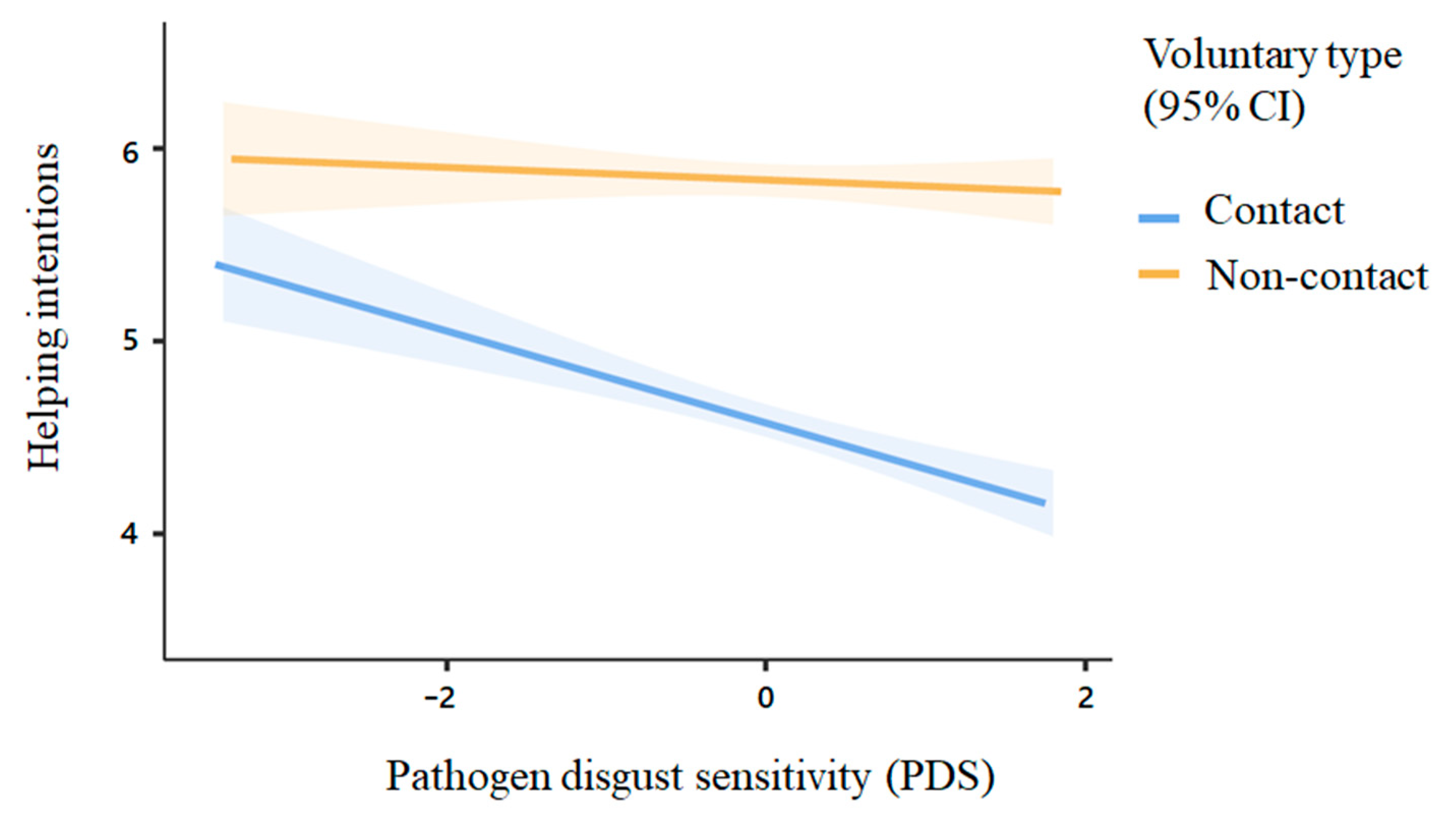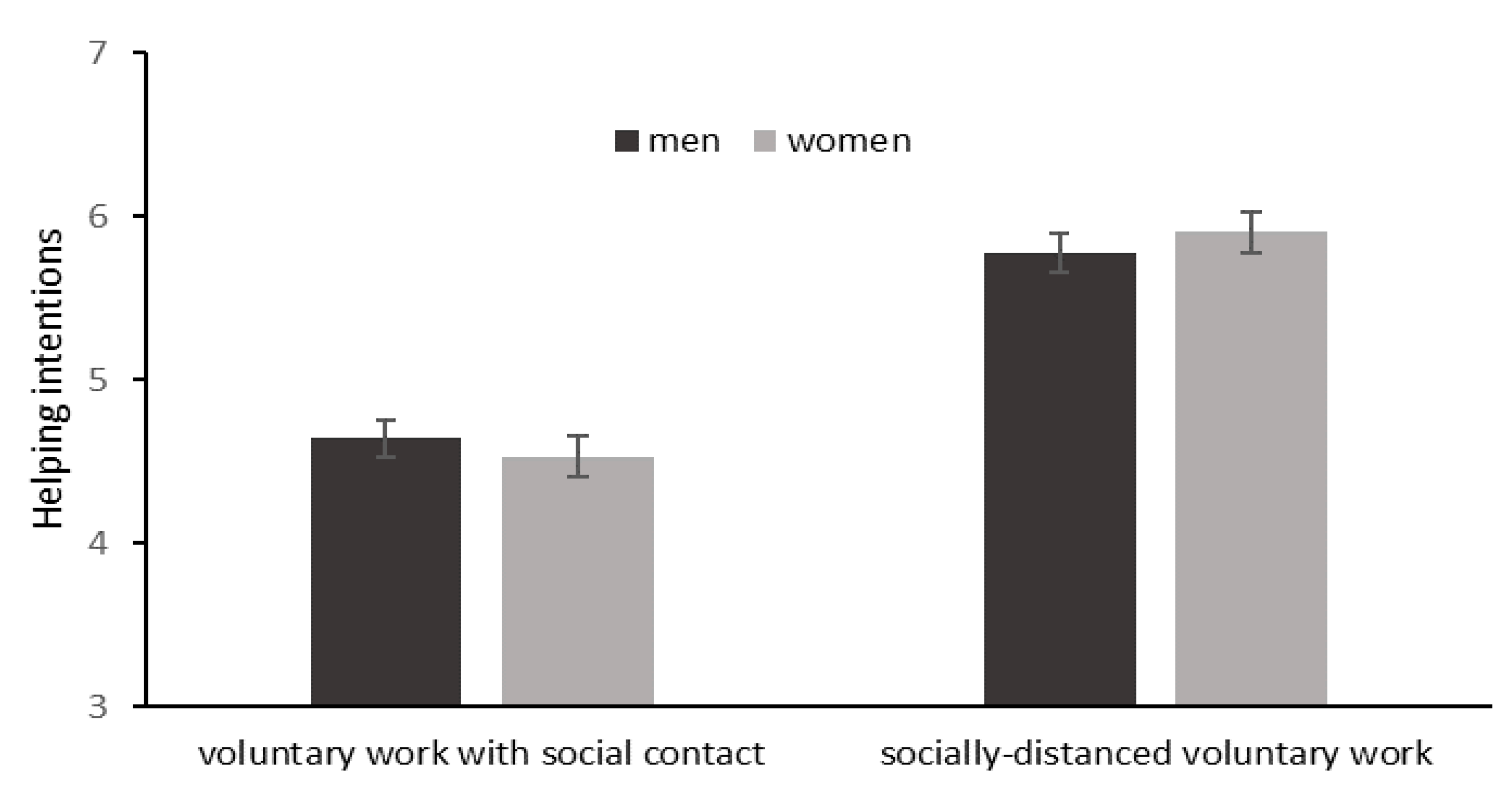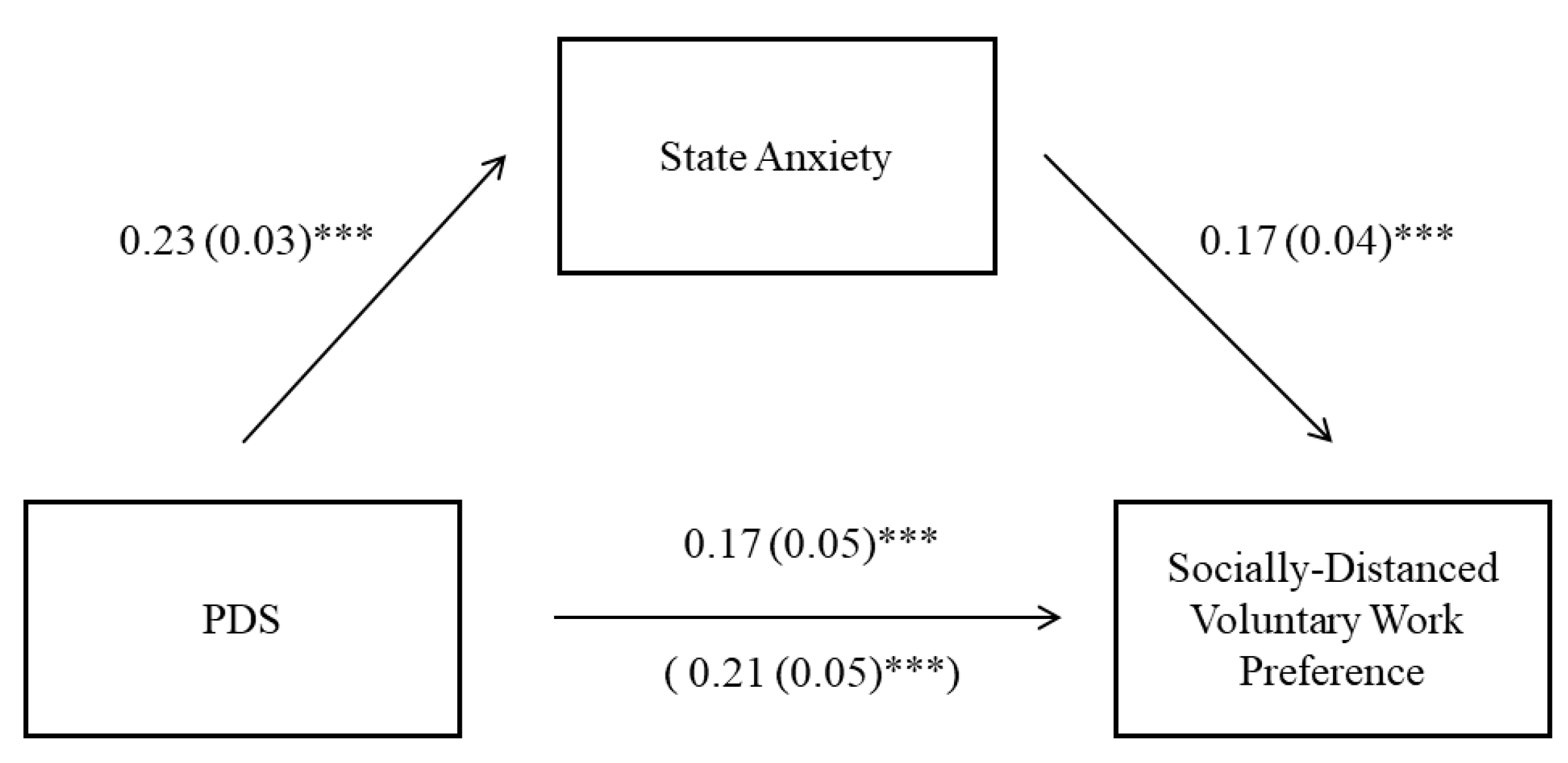Helping While Social Distancing: Pathogen Avoidance Motives Influence People’s Helping Intentions during the COVID-19 Pandemic
Abstract
1. Introduction
2. Materials and Methods
2.1. Participants and Design
2.2. Measures
2.2.1. Helping Intentions
2.2.2. Pathogen Disgust Sensitivity (PDS)
2.2.3. State Anxiety
2.2.4. Demographics
2.3. Data Analyses
3. Results
3.1. Common Method Variance Test
3.2. Correlations
3.3. Main Analyses
3.4. Mediation Analysis
4. Discussion
5. Conclusions
Author Contributions
Funding
Institutional Review Board Statement
Informed Consent Statement
Data Availability Statement
Conflicts of Interest
References
- World Health Organization. Director-General’s Opening Remarks at the Media Briefing on COVID-19. 11 March 2020. Available online: https://www.who.int/dg/speeches/detail/who-director-general-s-opening-remarks-at-themedia-briefing-on-covid-19—11-march-2020 (accessed on 1 August 2021).
- World Health Organization. Coronavirus Disease (COVID-19) Advice for the Public. 29 April 2020. Available online: https://www.who.int/emergencies/diseases/novel-coronavirus-2019/advice-for-public (accessed on 1 August 2021).
- Ceylan, M.; Hayran, C. Message Framing Effects on Individuals’ Social Distancing and Helping Behavior During the COVID-19 Pandemic. Front. Psychol. 2021, 12, 663. [Google Scholar] [CrossRef]
- Shook, N.J.; Sevi, B.; Lee, J.; Oosterhoff, B.; Fitzgerald, H.N. Disease avoidance in the time of COVID-19: The behavioral immune system is associated with concern and preventative health behaviors. PLoS ONE 2020, 15, e0238015. [Google Scholar] [CrossRef]
- Makhanova, A.; Shepherd, M.A. Behavioral immune system linked to responses to the threat of COVID-19. Personal. Individ. Differ. 2020, 167, 110221. [Google Scholar] [CrossRef] [PubMed]
- Murray, D.R.; Schaller, M. The behavioral immune system: Implications for social cognition, social interaction, and social influence. In Advances in Experimental Social Psychology; Olson, J.M., Zanna, M.P., Eds.; Academic Press: Cambridge, MA, USA, 2016; Volume 53, pp. 75–129. [Google Scholar] [CrossRef]
- Oaten, M.; Stevenson, R.J.; Case, T.I. Disgust as a disease-avoidance mechanism. Psychol. Bull. 2009, 135, 303–321. [Google Scholar] [CrossRef]
- Schaller, M.; Park, J.H. The behavioral immune system (and why it matters). Curr. Dir. Psychol. Sci. 2011, 20, 99–103. [Google Scholar] [CrossRef]
- Schaller, M. Parasites, behavioral defenses, and the social psychological mechanisms through which cultures are evoked. Psychol. Inq. 2006, 17, 96–137. [Google Scholar] [CrossRef]
- Randler, C.; Desch, I.H.; Kampe, V.O.; Wüst-Ackermann, P.; Wilde, M.; Prokop, P. Anxiety, disgust and negative emotions influence food intake in humans. Int. J. Gastron. Food Sci. 2017, 7, 11–15. [Google Scholar] [CrossRef][Green Version]
- Mortensen, C.R.; Becker, D.V.; Ackerman, J.M.; Neuberg, S.L.; Kenrick, D.T. Infection breeds reticence: The effects of disease salience on self-perceptions of personality and behavioral avoidance tendencies. Psychol. Sci. 2010, 21, 440–447. [Google Scholar] [CrossRef] [PubMed]
- Oaten, M.; Stevenson, R.J.; Case, T.I. Disease avoidance as a functional basis for stigmatization. Philos. Trans. R. Soc. B Biol. Sci. 2011, 366, 3433–3452. [Google Scholar] [CrossRef]
- Tybur, J.M.; Lieberman, D.; Kurzban, R.; DeScioli, P. Disgust: Evolved function and structure. Psychol. Rev. 2013, 120, 65–84. [Google Scholar] [CrossRef] [PubMed]
- Duncan, L.A.; Schaller, M. Prejudicial attitudes toward older adults may be exaggerated when people feel vulnerable to infectious disease: Evidence and implications. Anal. Soc. Issues Public Policy 2009, 9, 97–115. [Google Scholar] [CrossRef]
- Park, J.H.; Faulkner, J.; Schaller, M. Evolved disease-avoidance processes and contemporary antisocial behavior: Prejudicial attitudes and avoidance of people with physical disabilities. J. Nonverbal Behav. 2003, 27, 65–87. [Google Scholar] [CrossRef]
- Park, J.H.; Schaller, M.; Crandall, C.S. Pathogen-avoidance mechanisms and the stigmatization of obese people. Evol. Hum. Behav. 2007, 28, 410–414. [Google Scholar] [CrossRef]
- Faulkner, J.; Schaller, M.; Park, J.H.; Duncan, L.A. Evolved disease-avoidance mechanisms and contemporary xenophobic attitudes. Group Process. Intergroup Relat. 2004, 7, 333–353. [Google Scholar] [CrossRef]
- Ji, T.; Tybur, J.M.; van Vugt, M. Generalized or origin-specific out-group prejudice? The role of temporary and chronic pathogen-avoidance motivation in intergroup relations. Evol. Psychol. 2019, 17, 1–14. [Google Scholar] [CrossRef]
- Murray, D.R.; Fessler, D.M.; Kerry, N.; White, C.; Marin, M. The kiss of death: Three tests of the relationship between disease threat and ritualized physical contact within traditional cultures. Evol. Hum. Behav. 2017, 38, 63–70. [Google Scholar] [CrossRef]
- Fleischman, D.S.; Hamilton, L.D.; Fessler, D.M.; Meston, C.M. Disgust versus lust: Exploring the interactions of disgust and fear with sexual arousal in women. PLoS ONE 2015, 10, e0118151. [Google Scholar] [CrossRef]
- Brand, J.; McKay, D.; Wheaton, M.G.; Abramowitz, J.S. The relationship between obsessive compulsive beliefs and symptoms, anxiety and disgust sensitivity, and Swine Flu fears. J. Obs. -Compuls. Relat. Disord. 2013, 2, 200–206. [Google Scholar] [CrossRef]
- Wheaton, M.G.; Abramowitz, J.S.; Berman, N.C.; Fabricant, L.E.; Olatunji, B.O. Psychological predictors of anxiety in response to the H1N1 (swine flu) pandemic. Cogn. Ther. Res. 2012, 36, 210–218. [Google Scholar] [CrossRef]
- Blakey, S.M.; Reuman, L.; Jacoby, R.J.; Abramowitz, J.S. Tracing “Fearbola”: Psychological predictors of anxious responding to the threat of Ebola. Cogn. Ther. Res. 2015, 39, 816–825. [Google Scholar] [CrossRef]
- Ding, Y.; Yang, J.; Ji, T.; Guo, Y. Women Suffered More Emotional and Life Distress than Men during the COVID-19 Pandemic: The Role of Pathogen Disgust Sensitivity. Int. J. Environ. Res. Public Health 2021, 18, 8539. [Google Scholar] [CrossRef] [PubMed]
- Murray, D.R.; Trudeau, R.; Schaller, M. On the origins of cultural differences in conformity: Four tests of the pathogen prevalence hypothesis. Personal. Soc. Psychol. Bull. 2011, 37, 318–329. [Google Scholar] [CrossRef]
- Mo, T.; Layous, K.; Zhou, X.; Sedikides, C. Distressed but happy: Health workers and volunteers during the COVID-19 pandemic. Cult. Brain 2021, 5, 1–16. [Google Scholar] [CrossRef]
- Li, X.; Yu, H.; Bian, G.; Hu, Z.; Liu, X.; Zhou, Q.; Zhou, D. Prevalence, risk factors, and clinical correlates of insomnia in volunteer and at home medical staff during the COVID-19. Brain Behav. Immun. 2020, 87, 140–141. [Google Scholar] [CrossRef] [PubMed]
- Tybur, J.M.; Lieberman, D.; Griskevicius, V. Microbes, mating, and morality: Individual differences in three functional domains of disgust. J. Personal. Soc. Psychol. 2009, 97, 103–122. [Google Scholar] [CrossRef] [PubMed]
- Marteau, T.M.; Bekker, H. The development of a six-item short-form of the state scale of the Spielberger State—Trait Anxiety Inventory (STAI). Br. J. Clin. Psychol. 1992, 31, 301–306. [Google Scholar] [CrossRef] [PubMed]
- Podsakoff, P.M.; MacKenzie, S.B.; Lee, J.Y.; Podsakoff, N.P. Common method biases in behavioral research: A critical review of the literature and recommended remedies. J. Appl. Psychol. 2003, 88, 879–930. [Google Scholar] [CrossRef] [PubMed]
- Schaller, M. The behavioural immune system and the psychology of human sociality. Philos. Trans. R. Soc. B Biol. Sci. 2011, 366, 3418–3426. [Google Scholar] [CrossRef] [PubMed]
- Neuberg, S.L.; Kenrick, D.T.; Schaller, M. Human Threat Management Systems: Self-Protection and Disease Avoidance. Neurosci. Biobehav. Rev. 2011, 35, 1042–1051. [Google Scholar] [CrossRef]
- Tybur, J.M.; Lieberman, D. Human pathogen avoidance adaptations. Curr. Opin. Psychol. 2016, 7, 6–11. [Google Scholar] [CrossRef]
- Olatunji, B.O.; Armstrong, T.; Elwood, L. Is disgust proneness associated with anxiety and related disorders? A qualitative review and meta-analysis of group comparison and correlational studies. Perspect. Psychol. Sci. 2017, 12, 613–648. [Google Scholar] [CrossRef] [PubMed]
- McKay, D.; Yang, H.; Elhai, J.; Asmundson, G.J. Anxiety regarding contracting COVID-19 related to interoceptive anxiety sensations: The moderating role of disgust propensity and sensitivity. J. Anxiety Disord. 2020, 73, 102233. [Google Scholar] [CrossRef] [PubMed]
- Willems, R.C.; Drossaert, C.H.; Miedema, H.S.; Bohlmeijer, E.T. How demanding is volunteer work at a crisis line? An assessment of work-and organization-related demands and the relation with distress and intention to leave. Front. Public Health 2021, 9, 699116. [Google Scholar] [CrossRef] [PubMed]
- Van Willigen, M. Differential benefits of volunteering across the life course. J. Gerontol. Ser. B Psychol. Sci. Soc. Sci. 2000, 55, S308–S318. [Google Scholar] [CrossRef]
- Ackerman, J.M.; Tybur, J.M.; Blackwell, A.D. What role does pathogen-avoidance psychology play in pandemics? Trends Cogn. Sci. 2020, 25, 177–186. [Google Scholar] [CrossRef]
- Tybur, J.M.; Lieberman, D.; Fan, L.; Kupfer, T.R.; de Vries, R.E. Behavioral immune trade-offs: Interpersonal value relaxes social pathogen avoidance. Psychol. Sci. 2020, 31, 1211–1221. [Google Scholar] [CrossRef] [PubMed]




| Variable | Categories | Frequency | Percentage (%) |
|---|---|---|---|
| Age | 19–24 | 299 | 19.1% |
| 25–30 | 592 | 37.9% | |
| 31–40 | 443 | 28.4% | |
| 41–50 | 175 | 11.2% | |
| 51–60 | 53 | 3.4% | |
| Gender | Women | 719 | 46% |
| Men | 843 | 54% | |
| Educational Background | Primary school or less | 12 | 0.8% |
| Middle school graduate | 47 | 3% | |
| High school graduate or equivalent education completed | 129 | 8.3% | |
| Junior college graduate | 453 | 29% | |
| College graduate | 757 | 48.5% | |
| Postgraduate degree | 164 | 10.5% | |
| Average Personal Monthly Income in Chinese Yuan (i.e., CNY) | CNY <1000 | 102 | 6.5% |
| CNY 1000–2000 | 103 | 6.6% | |
| CNY 2000–3000 | 162 | 10.4% | |
| CNY 3000–5000 | 391 | 25% | |
| CNY 5000–8000 | 361 | 23.1% | |
| CNY 8000–12,000 | 251 | 16.1% | |
| CNY 12,000–15,000 | 82 | 5.2% | |
| CNY 15,000–20,000 | 42 | 3% | |
| CNY >20,000 | 63 | 4% |
| Variable | M | SD | 1 | 2 | 3 | 4 |
|---|---|---|---|---|---|---|
| 1. Pathogen disgust sensitivity | 4.45 | 0.99 | — | |||
| 2. State anxiety | 5.00 | 1.28 | 0.18 *** | — | ||
| 3. Voluntary work (with social contact) | 4.59 | 1.95 | −0.12 *** | −0.14 *** | — | |
| 4. Voluntary work (socially distanced) | 5.83 | 1.42 | −0.02 | −0.02 | 0.38 *** | — |
Publisher’s Note: MDPI stays neutral with regard to jurisdictional claims in published maps and institutional affiliations. |
© 2021 by the authors. Licensee MDPI, Basel, Switzerland. This article is an open access article distributed under the terms and conditions of the Creative Commons Attribution (CC BY) license (https://creativecommons.org/licenses/by/4.0/).
Share and Cite
Ding, Y.; Ji, T.; Guo, Y. Helping While Social Distancing: Pathogen Avoidance Motives Influence People’s Helping Intentions during the COVID-19 Pandemic. Int. J. Environ. Res. Public Health 2021, 18, 12113. https://doi.org/10.3390/ijerph182212113
Ding Y, Ji T, Guo Y. Helping While Social Distancing: Pathogen Avoidance Motives Influence People’s Helping Intentions during the COVID-19 Pandemic. International Journal of Environmental Research and Public Health. 2021; 18(22):12113. https://doi.org/10.3390/ijerph182212113
Chicago/Turabian StyleDing, Yi, Tingting Ji, and Yongyu Guo. 2021. "Helping While Social Distancing: Pathogen Avoidance Motives Influence People’s Helping Intentions during the COVID-19 Pandemic" International Journal of Environmental Research and Public Health 18, no. 22: 12113. https://doi.org/10.3390/ijerph182212113
APA StyleDing, Y., Ji, T., & Guo, Y. (2021). Helping While Social Distancing: Pathogen Avoidance Motives Influence People’s Helping Intentions during the COVID-19 Pandemic. International Journal of Environmental Research and Public Health, 18(22), 12113. https://doi.org/10.3390/ijerph182212113








